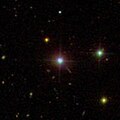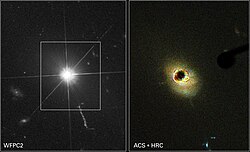Quasar



Quasars or quasi-stellar radio sources are the most energetic and distant active galactic nuclei (AGN).
They are quite small in comparison with the energy they put out. Quasars are not much larger than the Solar System.[3] The mechanism of brightness changes, probably involves relativistic beaming of jets pointed nearly directly toward us.[4] The highest redshift quasar known (as of June 2011[update]) has a redshift of 7.085, which means it is about 29 billion light-years from Earth. This estimate is made using the concept of comoving distance.
Scientists now agree that a quasar is a compact region in the center of a massive galaxy surrounding a central supermassive black hole.[5] Its size is 10–10,000 times the Schwarzschild radius of the black hole. The energy emitted by a quasar is gravitational energy, created from mass falling onto the accretion disc around the black hole.
Quasars are extremely luminous. They were first identified as being high redshift sources of electromagnetic radiation, including radio waves and visible light. The light (and other energy) appeared to be similar to stars, rather than large sources like galaxies. On the other hand, their spectra had very broad emission lines, unlike any known from stars, hence "quasi-stellar". Their luminosity can be 100 times greater than that of the Milky Way.[6]
The accretion discs of central supermassive black holes can convert about 10% of the mass of an object into energy.[7] This mechanism explains why quasars were more common in the early universe, as this energy production ends when the supermassive black hole consumes all of the gas and dust near it.
This means that most galaxies, including our own Milky Way, may have gone through an active stage as a quasar or some other class of active galaxy. They are now dormant because they lack a supply of matter to feed into their central black holes to generate radiation.
Brightest quasars
The most luminous (or brightest) thing in space (as of 2024's first quarter), is QSO J0529-4351, a quasar.[8][9][10]
Quasar Media
Sloan Digital Sky Survey image of quasar 3C 273, illustrating the object's star-like appearance. The quasar's jet can be seen extending downward and to the right from the quasar.
Hubble images of quasar 3C 273. At right, a coronagraph is used to block the quasar's light, making it easier to detect the surrounding host galaxy.
Cloud of gas around the distant quasar SDSS J102009.99+104002.7, taken by MUSE
A cosmic mirage known as the Einstein Cross. Four apparent images are actually from the same quasar.
Spectrum from quasar HE 0940-1050 after it has travelled through intergalactic medium
This view, taken with infrared light, is a false-color image of a quasar-starburst tandem with the most luminous starburst ever seen in such a combination.
The energetic radiation of the quasar makes dark galaxies glow, helping astronomers to understand the obscure early stages of galaxy formation.
Animation shows the alignments between the spin axes of quasars and the large-scale structures that they inhabit.
References
- ↑ Most distant quasar found. http://www.eso.org/public/news/eso1122/. Retrieved 4 July 2011.
- ↑ Gravitationally lensed quasar HE 1104-1805. http://www.spacetelescope.org/images/heic1116a/. Retrieved 4 November 2011.
- ↑ "Hubble surveys the "homes" of quasars". HubbleSite. 1996-11-19. Archived from the original on 2016-07-06. Retrieved 2011-07-01.
- ↑ By that is meant: a beam at near the speed of light appears brighter to us by a kind of Doppler effect.
- ↑ Irion, Robert. "A quasar in every galaxy?" (PDF). Sky and Telescope. New Track Media. Archived from the original (PDF) on 21 March 2016. Retrieved 20 February 2014.
- ↑ Greenstein, Jesse L.; Schmidt, Maarten (1964). "The quasi-stellar radio sources 3C 48 and 3C 273". The Astrophysics Journal. 140: 1. Bibcode:1964ApJ...140....1G. doi:10.1086/147889. S2CID 123147304. Retrieved 25 April 2014.
- ↑ as compared to 0.7% for the p-p chain nuclear fusion process that dominates the energy production in Sun-like stars.
- ↑ (The Guardian)
- ↑ (Nature Astronomy)
- ↑ https://yle.fi/a/74-20075472. Retrieved 2024-02-20







